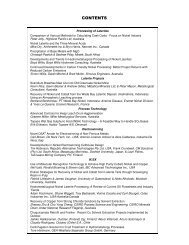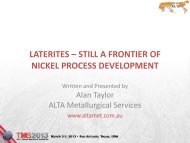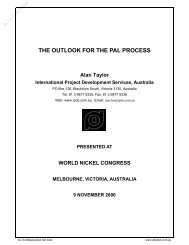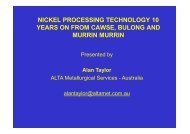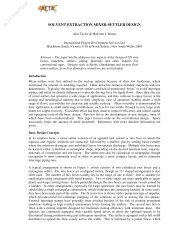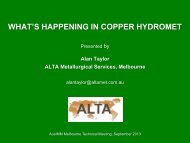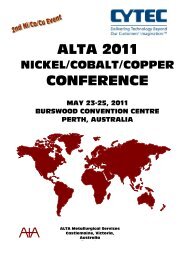the use of stainless and other high performance alloys in ...
the use of stainless and other high performance alloys in ...
the use of stainless and other high performance alloys in ...
You also want an ePaper? Increase the reach of your titles
YUMPU automatically turns print PDFs into web optimized ePapers that Google loves.
ALTA Free PaperTHE USE OF STAINLESS AND OTHER HIGHPERFORMANCE ALLOYS INHYDROMETALLURGICAL PROCESSPLANTS FOR THE RECOVERY OF METALSAlan TaylorInternational Project Development Services, AustraliaPO Box 126, Blackburn South, Victoria 3130, AustraliaTel: 61 3 9877 9335, Fax: 61 3 9877 9336Web: www.ipds.com.au, Email: ataylor@ipds.com.auPRESENTED ATASSDA EIGHTH NATIONAL STAINLESS STEELCONFERENCEGOLD COAST, QUEENSLAND, AUSTRALIA27 OCTOBER 2000ALTA Metallurgical Serviceswww.altamet.com.au
ALTA Free Paper1. INTRODUCTIONHydrometallurgical processes are be<strong>in</strong>g <strong>in</strong>creas<strong>in</strong>gly <strong>use</strong>d for <strong>the</strong> recovery <strong>of</strong> metals such as nickel,cobalt, copper, gold <strong>and</strong> z<strong>in</strong>c. This is good news for <strong>the</strong> <strong>sta<strong>in</strong>less</strong> steel <strong>in</strong>dustry, as <strong>the</strong> <strong>of</strong>ten <strong>high</strong>lycorrosive conditions <strong>in</strong> hydrometallurgical plants require <strong>the</strong> <strong>use</strong> <strong>of</strong> significant quantities <strong>of</strong> <strong>sta<strong>in</strong>less</strong>steel <strong>and</strong> <strong>high</strong>-nickel <strong>alloys</strong>.2. HYDROMETALLURGICAL PROCESS TRENDS2.1 TREATMENT OF NICKEL/COBALT LATERITES BY THE PAL PROCESSThe outst<strong>and</strong><strong>in</strong>g development <strong>in</strong> <strong>the</strong> nickel <strong>in</strong>dustry <strong>in</strong> <strong>the</strong> last decade is <strong>the</strong> construction <strong>of</strong> threenew pressure acid leach<strong>in</strong>g (PAL) plants <strong>in</strong> Western Australia for <strong>the</strong> treatment <strong>of</strong> nickel/cobaltlaterites. Traditionally laterites have been processed by smelt<strong>in</strong>g to produce ferronickel or matte forfur<strong>the</strong>r ref<strong>in</strong><strong>in</strong>g. A few reduction roast-ammonia leach plants have been built for lower gradelaterites for which smelt<strong>in</strong>g is uneconomic. However, this process has only been able to achievenickel recoveries <strong>in</strong> <strong>the</strong> range <strong>of</strong> 75-85%, <strong>and</strong> cobalt recoveries <strong>of</strong> 35-45%. Only one previous PALplant has been <strong>in</strong>stalled. This is <strong>the</strong> Moa Bay operation <strong>in</strong> Cuba, <strong>in</strong>itially established by Freeport <strong>in</strong><strong>the</strong> late fifties, <strong>and</strong> subsequently taken over by <strong>the</strong> Cubans shortly after commission<strong>in</strong>g. Moa Bay isstill operat<strong>in</strong>g, now with <strong>the</strong> <strong>in</strong>volvement <strong>of</strong> Sherritt who process <strong>the</strong> sulphide product at <strong>the</strong>irref<strong>in</strong>ery <strong>in</strong> Canada. The PAL process was subjected to extensive fur<strong>the</strong>r development by Amax <strong>and</strong>Nical <strong>in</strong> <strong>the</strong> USA <strong>in</strong> <strong>the</strong> seventies <strong>and</strong> eighties, though nei<strong>the</strong>r development proceeded through to acommercial scale operation. However, <strong>the</strong>se developments, toge<strong>the</strong>r with <strong>the</strong> advent <strong>of</strong> pressureoxidation operations for gold, z<strong>in</strong>c <strong>and</strong> uranium recovery, <strong>and</strong> <strong>the</strong> development <strong>of</strong> new solventextraction technology, provided a platform for <strong>the</strong> launch <strong>of</strong> <strong>the</strong> Bulong, Murr<strong>in</strong> Murr<strong>in</strong> <strong>and</strong> Cawseprojects <strong>in</strong> WA. The key attractions <strong>of</strong> <strong>the</strong> PAL process are <strong>high</strong> recoveries <strong>of</strong> both nickel <strong>and</strong>cobalt, <strong>the</strong> absence <strong>of</strong> <strong>the</strong> energy consum<strong>in</strong>g pre-dry<strong>in</strong>g step needed for <strong>the</strong> smelt<strong>in</strong>g <strong>and</strong> reductionroast routes, <strong>the</strong> potentially lower operat<strong>in</strong>g cost <strong>and</strong> applicability to a wider range <strong>of</strong> ores.The front end <strong>of</strong> each <strong>of</strong> <strong>the</strong> three new WA PAL plants is similar, <strong>and</strong> can be viewed as amodernised version <strong>of</strong> Moa Bay. All three utilise titanium clad autoclave construction toaccommodate process water <strong>of</strong> vary<strong>in</strong>g levels <strong>of</strong> sal<strong>in</strong>ity, which did not occur at Moa. The ma<strong>in</strong>differences between <strong>the</strong> three lie <strong>in</strong> <strong>the</strong> downstream process flowsheet, which varies markedly.Beca<strong>use</strong> <strong>of</strong> <strong>the</strong> huge <strong>in</strong>vestment, <strong>the</strong>re was a strong <strong>in</strong>centive to <strong>use</strong> proven process route forMurr<strong>in</strong> Murr<strong>in</strong>. Thus, precipitation <strong>of</strong> a mixed sulphide was adopted, as at Moa Bay; however an onsiteref<strong>in</strong>ery was <strong>in</strong>cluded. Cawse, as <strong>the</strong> late starter, plumped for <strong>the</strong> precipitation <strong>of</strong> mixedhydroxides followed by on-site ref<strong>in</strong><strong>in</strong>g via ammonia leach<strong>in</strong>g, solvent extraction (SX) <strong>and</strong>electrow<strong>in</strong>n<strong>in</strong>g. This utilised process “build<strong>in</strong>g blocks” proven <strong>in</strong> o<strong>the</strong>r operations, <strong>and</strong> <strong>of</strong>fered <strong>the</strong>best opportunity for a fast-track schedule. On <strong>the</strong> o<strong>the</strong>r h<strong>and</strong>, <strong>the</strong> pioneer Bulong project had <strong>the</strong>longest development period, which allowed time to optimise <strong>the</strong> process route. This is <strong>the</strong> most<strong>in</strong>novative <strong>of</strong> <strong>the</strong> three, <strong>and</strong> <strong>in</strong>volves <strong>the</strong> application <strong>of</strong> sequential SX directly to <strong>the</strong> pressure leachsolution <strong>in</strong> order to m<strong>in</strong>imise cost. The three process routes are depicted <strong>in</strong> Figure 1,2 <strong>and</strong> 3.The PAL process <strong>in</strong>volves leach<strong>in</strong>g <strong>in</strong> strong sulphuric acid solution at about 250 0 C <strong>and</strong> elevatedpressure <strong>in</strong> autoclaves, which are served by large preheat<strong>in</strong>g <strong>and</strong> pressure let-down systems.These are followed by extensive solid/liquid separation <strong>and</strong> product recovery facilities, which treat<strong>the</strong> result<strong>in</strong>g leach slurry at temperatures typically between 40 <strong>and</strong> 100 0 C. These extremelyaggressive conditions, aggravated <strong>in</strong> <strong>the</strong> WA operations by <strong>the</strong> <strong>use</strong> <strong>of</strong> sal<strong>in</strong>e process water, presentmajor materials <strong>of</strong> construction challenges. Materials utilised for <strong>the</strong> autoclaves <strong>and</strong> associatedpreheat<strong>in</strong>g <strong>and</strong> let-down systems <strong>in</strong>clude titanium clad steel, brick l<strong>in</strong><strong>in</strong>g, <strong>high</strong>-nickel <strong>alloys</strong> <strong>and</strong>tantalum. For <strong>the</strong> subsequent facilities, <strong>high</strong>-nickel <strong>alloys</strong>, <strong>sta<strong>in</strong>less</strong> steels, rubber l<strong>in</strong><strong>in</strong>gs, HDPE,FRP, o<strong>the</strong>r plastics <strong>and</strong> polymer concrete are typically <strong>use</strong>d. Factors affect<strong>in</strong>g material selection<strong>in</strong>clude capital cost, availability <strong>of</strong> supply, ma<strong>in</strong>tenance time <strong>and</strong> costs, <strong>and</strong> safety. The presence <strong>of</strong>chloride <strong>in</strong> solution, as <strong>in</strong> <strong>the</strong> WA plants, is ano<strong>the</strong>r major issue, which can significantly affect <strong>the</strong>choice <strong>of</strong> materials. Larger operations, such as Murr<strong>in</strong> Murr<strong>in</strong>, will likely <strong>in</strong>clude on-site acid plants,as <strong>the</strong> by-product energy can be <strong>use</strong>d to reduce operat<strong>in</strong>g costs.International project Development Services Page 1 October 2000ALTA Metallurgical Serviceswww.altamet.com.au
ALTA Free PaperThe new PAL plants have experienced difficult commission<strong>in</strong>g periods <strong>and</strong> relatively slow ramp-up.However, <strong>the</strong> processes have basically worked <strong>and</strong> it appears that product quality targets will beachieved. The Cawse operation has been <strong>the</strong> most trouble free, <strong>and</strong> has achieved design capacity.Although “<strong>the</strong> jury is still out” as far as operat<strong>in</strong>g costs are concerned, expansions are be<strong>in</strong>gplanned, <strong>and</strong> a number <strong>of</strong> new projects are press<strong>in</strong>g on with detailed feasibility studies. In timehonoured fashion, <strong>the</strong> next projects are expect<strong>in</strong>g to benefit from <strong>the</strong> experiences <strong>of</strong> <strong>the</strong> exist<strong>in</strong>gplants. At <strong>the</strong>ir presentation at <strong>the</strong> ALTA Nickel/Cobalt 2000 conference, Inco stated that most <strong>of</strong><strong>the</strong> future <strong>in</strong>crease <strong>in</strong> nickel production will come from laterite PAL operations. Inco <strong>the</strong>mselves arecurrently operat<strong>in</strong>g a major demonstration PAL operation for <strong>the</strong>ir Goro project <strong>in</strong> New Caledonia.New PAL developments <strong>in</strong>clude Ravensthorpe, NiWest, Marlborough, Syerston <strong>and</strong> Young <strong>in</strong>Australia, Ramu <strong>in</strong> PNG, <strong>and</strong> Weda Bay <strong>in</strong> Indonesia, plus o<strong>the</strong>rs <strong>in</strong> New Caledonia, Africa <strong>and</strong> <strong>the</strong>Philipp<strong>in</strong>es.2.2 PRESSURE OXIDATION OF SULPHIDE ORES AND CONCENTRATESPressure oxidation is already a well-established technology, with successful commercial operationsfor <strong>the</strong> treatment <strong>of</strong> gold, z<strong>in</strong>c <strong>and</strong> uranium sulphide ores <strong>and</strong> concentrates. Based on <strong>the</strong>sesuccesses, significant efforts are be<strong>in</strong>g made to extend <strong>the</strong> technology to o<strong>the</strong>r sulphides such ascopper <strong>and</strong> nickel. Driv<strong>in</strong>g forces <strong>in</strong>clude environmental concerns with smelt<strong>in</strong>g, <strong>the</strong> desire <strong>of</strong> small<strong>and</strong> medium sizes m<strong>in</strong>ers to produce metals <strong>in</strong>stead <strong>of</strong> rely<strong>in</strong>g on toll smelters, <strong>and</strong> <strong>the</strong> treatment <strong>of</strong>impure <strong>and</strong>/or low grade concentrates unsuitable for smelt<strong>in</strong>g. Reflect<strong>in</strong>g <strong>the</strong> <strong>in</strong>terest <strong>and</strong> <strong>the</strong> need,a number <strong>of</strong> development programs are underway, some <strong>of</strong> which have reached pilot <strong>and</strong>demonstration scale. Examples <strong>in</strong>clude <strong>the</strong> Mt Gordon, CESL, Activox, Dynatec <strong>and</strong> NSCprocesses, which operate under various process conditions. In <strong>the</strong> case <strong>of</strong> copper, <strong>the</strong> Mt Gordon<strong>and</strong> NSC process have already been commercialised, <strong>in</strong> Australia <strong>and</strong> <strong>the</strong> USA respectively, while<strong>the</strong> CESL process is reported to be close to commercialisation after extensive pilot <strong>and</strong>demonstration plant campaigns. For nickel, <strong>the</strong> Activox process is <strong>in</strong> <strong>the</strong> f<strong>in</strong>al stages <strong>of</strong> pilot<strong>in</strong>g forprojects <strong>in</strong> Africa, Inco is reported to be test<strong>in</strong>g pressure oxidation for <strong>the</strong>ir Voisey’s Bay project <strong>in</strong>Canada, while <strong>the</strong> Platsol process is be<strong>in</strong>g piloted for <strong>the</strong> Northmet polymetallic project <strong>in</strong> <strong>the</strong> USA.A typical flowsheet for copper recovery is shown <strong>in</strong> Figure 4.Pressure oxidation <strong>in</strong>volves <strong>the</strong> <strong>use</strong> <strong>of</strong> oxygen under pressure <strong>in</strong> autoclaves to break down <strong>the</strong>metal sulphides <strong>and</strong> liberate <strong>the</strong> metals for subsequent recovery. The solutions <strong>in</strong> <strong>the</strong> autoclavesare generally acidic <strong>and</strong> corrosive, <strong>and</strong> <strong>in</strong> some processes conta<strong>in</strong> significant chloride.Temperatures are <strong>in</strong> <strong>the</strong> range <strong>of</strong> 100-230 0 C, depend<strong>in</strong>g on <strong>the</strong> type <strong>of</strong> process <strong>and</strong> <strong>the</strong>characteristics <strong>of</strong> <strong>the</strong> feed material. In <strong>the</strong> case <strong>of</strong> gold, <strong>the</strong> autoclave discharge is neutralised priorto cyanidation, so that <strong>the</strong> corrosive conditions are conf<strong>in</strong>ed to <strong>the</strong> autoclave system. However, <strong>in</strong><strong>the</strong> o<strong>the</strong>r applications, <strong>the</strong> downstream process steps are also carried out <strong>in</strong> corrosive conditions,so that most <strong>of</strong> <strong>the</strong> operations require corrosion resistant materials. Depend<strong>in</strong>g on temperature,pressure <strong>and</strong> solution, <strong>the</strong> materials <strong>use</strong>d <strong>in</strong> <strong>the</strong> autoclave system <strong>in</strong>clude brick l<strong>in</strong><strong>in</strong>g, titanium,<strong>high</strong>-nickel <strong>alloys</strong> <strong>and</strong> <strong>sta<strong>in</strong>less</strong> steels. For <strong>the</strong> rest <strong>of</strong> <strong>the</strong> facilities, typical materials <strong>in</strong>clude<strong>sta<strong>in</strong>less</strong> steels, <strong>high</strong>-nickel <strong>alloys</strong>, rubber l<strong>in</strong><strong>in</strong>g, HDPE, FRP, o<strong>the</strong>r plastics <strong>and</strong> wood.Successful treatment <strong>of</strong> chalcopyrite <strong>in</strong> particular, which is <strong>the</strong> ma<strong>in</strong> source m<strong>in</strong>eral for <strong>the</strong> world’scopper, could lead to a proliferation <strong>of</strong> pressure oxidation plants <strong>in</strong> <strong>the</strong> future.2.3 BIO-OXIDATION OF SULPHIDE ORES AND CONCENTRATESBio-oxidation is also well established for treat<strong>in</strong>g sulphidic gold concentrates, <strong>and</strong> <strong>the</strong> first plant forcobalt recovery is <strong>in</strong> <strong>the</strong> early stages <strong>of</strong> operation <strong>in</strong> Kilembe <strong>in</strong> Ug<strong>and</strong>a treat<strong>in</strong>g tail<strong>in</strong>gs from aformer copper operation. The process is also a competitor with pressure oxidation for <strong>the</strong> futuretreatment <strong>of</strong> copper <strong>and</strong> nickel sulphides. Major development programs are be<strong>in</strong>g undertaken byBactech/M<strong>in</strong>tek <strong>and</strong> Billiton, both <strong>of</strong> whom have run successful pilot plant operations for <strong>the</strong>treatment <strong>of</strong> copper <strong>and</strong> nickel feedstocks <strong>and</strong> are press<strong>in</strong>g on strongly towards commercialisation.As with pressure oxidation, successful commercialisation for <strong>the</strong> treatment <strong>of</strong> chalcopyriteconcentrates would open up a potentially large market. A typical flowsheet for copper recovery isgiven <strong>in</strong> Figure 5. On ano<strong>the</strong>r front, Pacific Ore are pilot<strong>in</strong>g a bio-oxidation heap leach<strong>in</strong>g processat Titan Resources’ Radio Hill nickel/copper facility <strong>in</strong> WA. Promis<strong>in</strong>g results have been recentlyannounced, <strong>and</strong> negotiations are reported to be <strong>in</strong> progress with WMC <strong>and</strong> o<strong>the</strong>r parties <strong>in</strong>terested<strong>in</strong> apply<strong>in</strong>g <strong>the</strong> technology. If successful, it could open <strong>the</strong> dor to <strong>the</strong> treatment <strong>of</strong> extensive lowgrade nickel sulphide resources currently uneconomic with exist<strong>in</strong>g technology.International project Development Services Page 2 October 2000ALTA Metallurgical Serviceswww.altamet.com.au
ALTA Free PaperFrom <strong>the</strong> materials po<strong>in</strong>t <strong>of</strong> view, <strong>the</strong>se processes <strong>in</strong>volve <strong>the</strong> process<strong>in</strong>g <strong>of</strong> sulphuric acid solutionsconta<strong>in</strong><strong>in</strong>g a variety <strong>of</strong> impurities at temperature vary<strong>in</strong>g from ambient up to about 80 0 C, atatmospheric pressure. Chloride contents are generally low compared with some <strong>of</strong> <strong>the</strong> pressureoxidation processes.2.4 CHLORIDE LEACHING PROCESSESA chloride/sulphate leach<strong>in</strong>g process has been <strong>in</strong> operation at Pasm<strong>in</strong>co’s Pt Pirie lead operationfor many years, recover<strong>in</strong>g copper from a copper/lead matte. Recently <strong>the</strong> process has beenconsidered for <strong>the</strong> treatment <strong>of</strong> copper sulphide ores <strong>and</strong> concentrates. For example, pilot scaletestwork has been reported for Leadstar’s Labuk project <strong>in</strong> East Malaysia. In ano<strong>the</strong>r development,Intec have undertaken extensive campaigns with <strong>the</strong>ir demonstration plant <strong>in</strong> Sydney us<strong>in</strong>g <strong>the</strong>ir<strong>in</strong>novative chloride leach<strong>in</strong>g process. Aga<strong>in</strong>, <strong>the</strong> target is chalcopyrite concentrates. They arereported to be aggressively pursu<strong>in</strong>g opportunities for <strong>the</strong> first commercial application. Thisdevelopment has been supported by a consortium <strong>of</strong> major copper companies. The flowsheet isillustrated <strong>in</strong> Figure 6. As with previous attempts to develop chloride processes for copperproduction, materials selection is a crucial issue. The fact that no autoclaves are <strong>in</strong>volved <strong>in</strong> <strong>the</strong>above processes is an advantage.Chloride leach<strong>in</strong>g also features strongly <strong>in</strong> <strong>the</strong> current push for new magnesium metal projects <strong>in</strong>Australia. A prom<strong>in</strong>ent example is <strong>the</strong> Kunwarrara project <strong>in</strong> Queensl<strong>and</strong>, for which a demonstrationscale plant has been operated.2.5 COPPER HEAP LEACHINGS<strong>in</strong>ce <strong>the</strong> early n<strong>in</strong>eteen seventies, <strong>the</strong>re has been an explosion <strong>of</strong> copper heap leach<strong>in</strong>goperations, particularly <strong>in</strong> <strong>the</strong> USA <strong>and</strong> Chile. From relatively small beg<strong>in</strong>n<strong>in</strong>gs, <strong>the</strong>y have grownever larger <strong>in</strong> size. One <strong>of</strong> <strong>the</strong> ma<strong>in</strong> reasons is <strong>the</strong> relative ease <strong>in</strong> which <strong>high</strong> grade cathodecopper can be produced at <strong>the</strong> m<strong>in</strong>e site by <strong>the</strong> application <strong>of</strong> solvent extraction <strong>and</strong> electrow<strong>in</strong>n<strong>in</strong>g,SX/EW. A major advance <strong>in</strong> this technology was <strong>the</strong> successful development <strong>of</strong> <strong>the</strong> directdeposition <strong>of</strong> copper cathodes onto <strong>sta<strong>in</strong>less</strong> steel plates by MIM <strong>in</strong> Queensl<strong>and</strong>, <strong>and</strong> later by KiddCreek <strong>in</strong> Canada. In recent years, heap leach<strong>in</strong>g/SX/EW has been successfully extended to coppersecondary sulphide ores, which has significantly widened <strong>the</strong> opportunities for new projects. Atypical flowsheet is shown <strong>in</strong> Figure 7.Apart from <strong>the</strong> significant amount <strong>of</strong> <strong>sta<strong>in</strong>less</strong> required for <strong>the</strong> EW plates, <strong>sta<strong>in</strong>less</strong> <strong>and</strong> <strong>high</strong>-nickel<strong>alloys</strong> are <strong>use</strong>d <strong>in</strong> o<strong>the</strong>r areas <strong>of</strong> <strong>the</strong> operation such as pumps, pip<strong>in</strong>g, mixer-settlers, tanks, filters<strong>and</strong> heat exchangers. In some operations, <strong>the</strong> leach solutions conta<strong>in</strong> chloride, which may require<strong>high</strong>er <strong>alloys</strong>. Competitive materials <strong>in</strong>clude HDPE, FRP <strong>and</strong> o<strong>the</strong>r plastic l<strong>in</strong><strong>in</strong>gs.The MIM <strong>and</strong> Kid technologies were actually first developed for copper electroref<strong>in</strong><strong>in</strong>g, <strong>and</strong> havegone on to become st<strong>and</strong>ard <strong>in</strong> <strong>the</strong> <strong>in</strong>dustry, with numerous large scale operations. As with heapleach/SX/EW, electroref<strong>in</strong>eries widely <strong>use</strong> <strong>sta<strong>in</strong>less</strong> <strong>and</strong> o<strong>the</strong>r <strong>alloys</strong> for corrosive solutions.3. THE FUTURE?Although noth<strong>in</strong>g is ever certa<strong>in</strong>, many <strong>of</strong> <strong>the</strong> hydrometallurgical trends reviewed above are likely tocont<strong>in</strong>ue, thus open<strong>in</strong>g up new opportunities for <strong>sta<strong>in</strong>less</strong> steels <strong>and</strong> o<strong>the</strong>r <strong>alloys</strong>. Of course <strong>the</strong>rewill be strong competition from o<strong>the</strong>r materials such as plastics, <strong>and</strong>, for <strong>the</strong> more extremeapplications, titanium <strong>and</strong> tantalum. History has <strong>in</strong>dicated that <strong>the</strong>re is usually a balance, whichmeans that <strong>the</strong> <strong>sta<strong>in</strong>less</strong> <strong>in</strong>dustry should be ensured <strong>of</strong> a healthy portion <strong>of</strong> <strong>the</strong> bus<strong>in</strong>ess. This willbe assisted by <strong>the</strong> <strong>in</strong>dustry cont<strong>in</strong>u<strong>in</strong>g to be pro-active <strong>in</strong> develop<strong>in</strong>g appropriate new <strong>alloys</strong>,provid<strong>in</strong>g <strong>use</strong>ful corrosion <strong>and</strong> fabrication data to potential <strong>use</strong>rs, <strong>and</strong>, <strong>of</strong> course, by be<strong>in</strong>g costcompetitive.International project Development Services Page 3 October 2000ALTA Metallurgical Serviceswww.altamet.com.au
ALTA Free Paper4. REFERENCES1. Taylor, A, & Jansen, ML, “Future Trends <strong>in</strong> PAL Plant Design for Ni/Co Laterites”, ALTANickel/Cobalt 2000 Proceed<strong>in</strong>gs, Perth, Australia, May 15-17, 20002. Bacon, G, Dalvi, A, & Parker, MO, “Nickel Outlook – 2000 to 2010”, ALTA Nickel/Cobalt 2000Proceed<strong>in</strong>gs, Perth, Australia, May 15-18, 20003. Ma<strong>the</strong>son, PJ, “The Way Ahead”, ALTA Nickel/Cobalt 1999 Proceed<strong>in</strong>gs, Perth, Australia, May10-12, 19994. Taylor, A, & Jansen, ML, “Hydrometallurgical Treatment <strong>of</strong> Copper Sulphides – Are We on <strong>the</strong>Br<strong>in</strong>k”, ALTA Copper 1999 Proceed<strong>in</strong>gs, Brisbane, Australia, September 6-8, 1999.5. Taylor, A, “Bioheap Leach<strong>in</strong>g –Low Cost technology with a Bright Future”, M<strong>in</strong>erals Gazette,June 2000, p 26.6. “Report on <strong>the</strong> Inaugural Australian Magnesium Conference”, Australian Journal <strong>of</strong> Metals,August 1999, pp6-16.7. Johnson, S, “Tankho<strong>use</strong> Expansion <strong>and</strong> Modernisation <strong>of</strong> Copper Ref<strong>in</strong>eries LTD”, ALTA 1998 CCopper Hydrometallurgy Forum Proceed<strong>in</strong>gs, Brisbane, Australia, October 20-21, 1998.International project Development Services Page 4 October 2000ALTA Metallurgical Serviceswww.altamet.com.au
ALTA Free PaperFig 1.Simplified Bulong FlowsheetLaterite OreWaterFlocculantFEED PREPARATIONFEED PREPARATIONCoarse RejectsAcidSteamPRESSURE ACID LEACHINGPRESSURE ACID LEACHINGLimestoneFlocculantTHICKENING & NEUTRALISATIONTHICKENING & NEUTRALISATIONTail<strong>in</strong>gsOxygen Reagents PowerAmmoniaReagentsSodium SulphideNICKEL & COBALTNICKEL & COBALTSOLVENT EXTRACTIONSOLVENT EXTRACTIONCOBALT REFININGCOBALT REFININGReagentsPowerNICKEL ELECTROWINNINGNICKEL ELECTROWINNINGCobalt CathodesNickel CathodesInternational project Development Services Page 5 October 2000ALTA Metallurgical Serviceswww.altamet.com.au
ALTA Free PaperFig 2.Simplified Murr<strong>in</strong> Murr<strong>in</strong> FlowsheetLaterite OreWaterFEED PREPARATIONFEED PREPARATIONCoarse RejectsAcidSteamPRESSURE ACID LEACHINGPRESSURE ACID LEACHINGCalcreteFlocculantTHICKENING & NEUTRALISATIONTHICKENING & NEUTRALISATIONTail<strong>in</strong>gsSteamHydrogen SulphideMIXED SULPHIDESMIXED SULPHIDESPRECIPITATIONPRECIPITATIONOxygenAmmoniaHydrogenReagentsSteamNICKEL & COBALTNICKEL & COBALTREFININGREFININGNickelBriquettesCobaltBriquettesAmmoniumSulphateInternational project Development Services Page 6 October 2000ALTA Metallurgical Serviceswww.altamet.com.au
ALTA Free PaperFig 3.Simplified Cawse FlowsheetLateriteOreHigh CobaltOreWaterFlocculantFEED PREPARATIONFEED PREPARATION& UPGRADING& UPGRADINGUpgrade RejectsAcidSteamPRESSURE ACID LEACHINGPRESSURE ACID LEACHINGLimestoneFlocculantTHICKENING & NEUTRALISATIONTHICKENING & NEUTRALISATIONTail<strong>in</strong>gsMagnesiaLimeFlocculantMIXED HYDROXIDESMIXED HYDROXIDESPRECIPITATIONPRECIPITATIONAmmoniaCarbon DioxideSteamReagentsAmmonium SulphidePowerNICKELNICKELREFININGREFININGNickelCathodesCobaltSulphidePrecipitateInternational project Development Services Page 7 October 2000ALTA Metallurgical Serviceswww.altamet.com.au
ALTA Free PaperFig. 4High Pressure Oxidation FlowsheetFeedConcentratesBleed toNeutralisation orOxide Leach<strong>in</strong>gOxygenPRESSUREOXIDATIONRaff<strong>in</strong>ateCCD CIRCUIT(Or Belt Filter)SolutionCOPPER SXSolidsLimestoneLimeNEUTRALISATIONCOPPER EWCyanideResidue toTail<strong>in</strong>gsGOLDRECOVERYCOPPER CATHODESGOLD BULLIONInternational project Development Services Page 8 October 2000ALTA Metallurgical Serviceswww.altamet.com.au
ALTA Free PaperFig. 5 Bio-Oxidation Process FlowsheetFeed ConcentratesFINE GRINDINGBleed toNeutralisationAirBIO-OXIDATIONNeutrientsRaff<strong>in</strong>ateCCD CIRCUIT(Or Belt Filter)SolutionCOPPER SXSolidsLimestoneLimeNEUTRALISATIONCOPPER EWCyanideResidue toTail<strong>in</strong>gsGOLD RECOVERYCOPPER CATHODESGOLD BULLIONInternational project Development Services Page 9 October 2000ALTA Metallurgical Serviceswww.altamet.com.au
ALTA Free PaperFig. 6 Intec Process FlowsheetFeed ConcentratesPLSLEACHINGGOLDRECOVERYGoldSolutionLIQUID/SOLIDSEPARATIONSolidsSULPHURRECOVERYTail<strong>in</strong>gsSulphurCLARIFICATIONTWO-STAGEPURIFICATIONElectrolyteAg, HgBi, As, SbZn, PbSpentSolutionELECTROWINNINGPRODUCTWASH/DRYBRIQUETTINGCONFORM MACHINECOPPERBRIQUETTESCOPPERWIRE/STRIPInternational project Development Services Page 10 October2000ALTA Metallurgical Serviceswww.altamet.com.au
ALTA Free Paper * + ! * ! $ %& # ' " # " # ( * ) ) # & # NOTES:NOTES:1. 1. Could Could <strong>use</strong> <strong>use</strong> trucks trucks <strong>in</strong>stead <strong>in</strong>stead <strong>of</strong> <strong>of</strong> stacker. stacker.2.2.Could <strong>use</strong> more than one lift.Could <strong>use</strong> more than one lift.3.3.Could <strong>use</strong> agglomeration if needed.Could <strong>use</strong> agglomeration if needed.4. Copper recovery plant <strong>in</strong>cludes SX/EW) ) # " ) # ) # ! -!$ , ! ) # ) #% '& #, ! International project Development Services Page 11 October 2000ALTA Metallurgical Serviceswww.altamet.com.au



